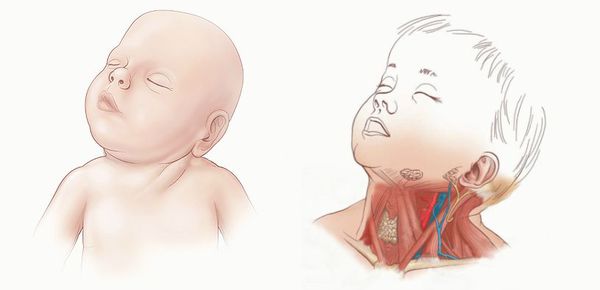Torticollis In Babies: What Are The Symptoms and How to Fix?

What Are The Symptoms Of Torticollis In Babies?
Tilted neck is the classic symptom of torticollis. Nevertheless, parents can look for the following signs of probable torticollis:
- Infant turns head only one way. For instance, if the baby suffers from right torticollis (head tilted towards the right), then he will always move the head to the left. If the baby has to look to the right, then he moves his entire body to the right.
- The infant prefers one breast for feeding. Since torticollis causes a limited range of head motion, the baby may have trouble latching to a breast. He may not act fussy while feeding on the other breast but will seem comfortable and contented when feeding on one.
- There is a thick lump of muscle on the neck. The presence of lump indicates a scar tissue. If the baby had an SCM muscle injury, then the parent can spot a small pea-sized lump on the muscle.
You can look out for these symptoms, which are clearly visible. If the signs are indicating torticollis, you need to go for professional diagnosis to ensure that the baby is treated promptly.

How Is Torticollis Diagnosed?
The healthcare professional will use one of these three ways to diagnose torticollis in babies:
- Visual and physical inspection: The obvious way to determine torticollis is through the inspection of the infant. The doctor may move the baby’s head and feel for any resistance from the SCM muscle. If the baby’s neck muscle was injured during delivery, then the physician will look for any external signs of scar tissue. Inspecting the baby right after the birth and again after a few days can help detect torticollis early. In the case of acquired torticollis, doctors look for the symptoms of any other health condition and will ask you about the infant’s medical history.
- X-ray: An X-ray gives a clear picture of the underlying bone structure. It helps detect the presence of torticollis or any other skeletal disorder in the baby.
- Ultrasound analysis: Ultrasound imaging is done with high-frequency sound waves, which establishes an accurate image of muscles and blood vessels. By assessing an ultrasound picture, the doctor can tell for sure whether the SCM muscles suffer from a problem.
How Is Torticollis Treated?
If the torticollis is acquired as a side effect of another disorder, then the doctor will treat that particular condition. If torticollis is a problem in itself, it could be treated in one of the below methods:
Physiotherapy is a non-invasive way of treating torticollis. Neck stretches and exercises can be done at home either by the parent or by a professional. If the parent has to take up the responsibility, they need to be trained by a certified pediatric physiotherapist. Stretches will be accompanied by scheduled visits to the pediatrician and physiotherapist to assess the progress of the treatment.
Remember, a parent must never attempt head stretch and neck movement on the baby without medical guidance and training. Consultation with a medical professional is necessary before performing any move on the baby’s delicate neck.
Stretches help release the tension in the SCM muscle and expand it back to its normal shape. The baby’s head is stretched gently in various directions thus reducing head tilt. An exercise regime ensures complete recovery of the muscle with its full range of motion.
A specialized infant tubular orthosis for torticollis (TOT) collar is a simple plastic frame that can be secured on a baby’s neck. It is also referred to as a brace. The TOT collar straightens the neck by putting gentle pressure on the opposite side of the tilt. It slowly brings the neck to the correct alignment by stretching the SCM muscle. The doctor will train the parents in putting on and taking off the collar. The baby will have to wear the collar for a prescribed number of hours every day. Most collars are washable since they are made from plastic or washable fabric. TOT collars are most likely to be recommended in combination with physical therapy.
A chit is a type of treatment that focuses on bone adjustment to relieve tension on muscles and nerves. The alternative medicine works well with other forms of non-invasive treatments such as physiotherapy. In a chiropractic adjustment, the chiropractor (a doctor) uses his hands to adjust the baby’s spine with calculated and precise moves. It is not a standard bone setting as the practitioner will conduct a detailed assessment before doing the adjustment. Chiropractic adjustments have been found to be effective at curing neck tilt, and experts believe it should be considered an option for torticollis treatment in infants.
Surgery: It is the last option if the baby does not respond to any other interventions. The surgery for torticollis in infants aims to reduce the SCM muscle tension and achieve a complete neck extension without any tilt. The exact surgical process depends on the severity of the torticollis. A standard operating procedure involves making an incision at the lower attachment point of SCM muscle on the chest. Here, the muscle is stripped from the bone, allowed to relax, and reattached with the corrected neck position .
How Can Parents Help A Baby With Torticollis?
There are some baby-safe means to counteract the effects of torticollis right at home. Here is what you can do:
- More tummy time: Pediatric experts vouch for all the positive effects this simple activity has on the baby’s overall physical development. Tummy time strengthens the baby’s neck and back muscles. It stimulates the baby to use multiple muscles.
- Baby, look the other way! One way to rectify the baby’s neck tilt is to encourage them to turn in the opposite direction. Use food or toys to lure the infant to turn in order to stimulate the natural and voluntary extension of the neck muscle. During feeds, the mother can place the bottle or feed the baby on the breast on the opposite direction of torticollis. Such stimulation relaxes and conditions the SCM muscle thus providing relief from torticollis in the long run.
- Watch the sleeping position: Parents must avoid carriers that immobilize the baby is one single position since it can increase the risk of plagiocephaly/flat head. Parents can use torticollis pillows to support the baby’s neck while sleeping. Experts recommend the use of specialized pillows to help babies sleep better. However, take your doctor’s advice before using a pillow.

Torticollis is not painful for the baby, but it could alter the facial features of the little one. Also, the infant will have difficulty in moving his head normally. The condition is treatable; therefore, observe for the signs and take your baby to a doctor if you suspect that his head is tilted. Timely treatment and the subsequent care are all the baby needs. The little one will grow up healthy and face the world with a good head on his shoulders.
Boston Infant Trainer can help your child not only to grow up healthy, strong and intelligent. Boston Infant Trainer knows and has long experience and professional understanding of how to fix torticollis . Contact us for 50% off your introductory session in Boston, Massachusetts area.